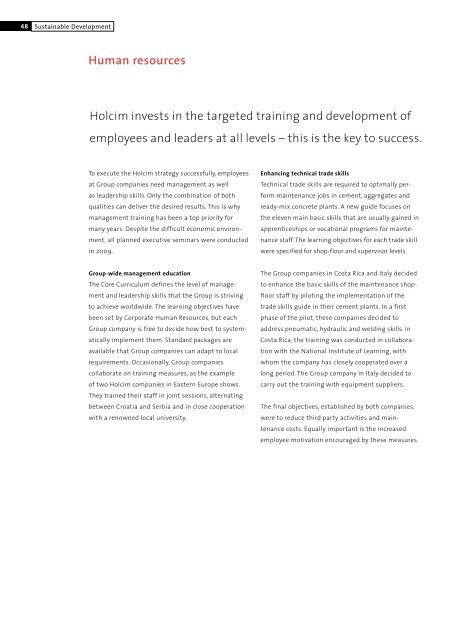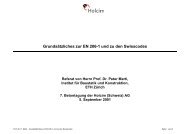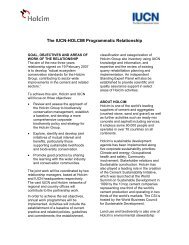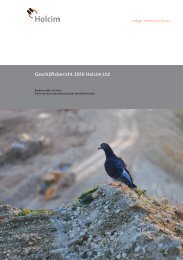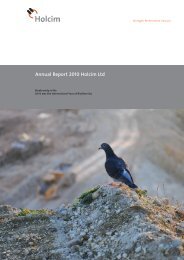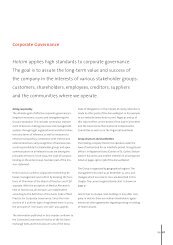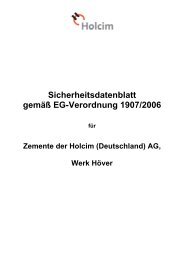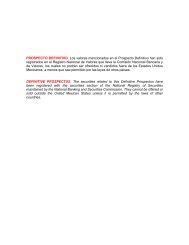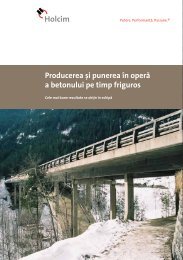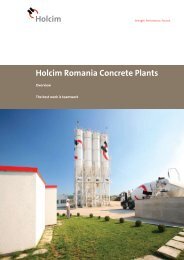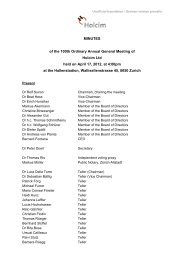Human resources - Holcim
Human resources - Holcim
Human resources - Holcim
Create successful ePaper yourself
Turn your PDF publications into a flip-book with our unique Google optimized e-Paper software.
48 Sustainable Development<br />
<strong>Human</strong> <strong>resources</strong><br />
<strong>Holcim</strong> invests in the targeted training and development of<br />
employees and leaders at all levels – this is the key to success.<br />
To execute the <strong>Holcim</strong> strategy successfully, employees<br />
at Group companies need management as well<br />
as leadership skills. Only the combination of both<br />
qualities can deliver the desired results. This is why<br />
management training has been a top priority for<br />
many years. Despite the difficult economic environment,<br />
all planned executive seminars were conducted<br />
in 2009.<br />
Group-wide management education<br />
The Core Curriculum defines the level of management<br />
and leadership skills that the Group is striving<br />
to achieve worldwide. The learning objectives have<br />
been set by Corporate <strong>Human</strong> Resources, but each<br />
Group company is free to decide how best to systematically<br />
implement them. Standard packages are<br />
available that Group companies can adapt to local<br />
requirements. Occasionally, Group companies<br />
collaborate on training measures, as the example<br />
of two <strong>Holcim</strong> companies in Eastern Europe shows.<br />
They trained their staff in joint sessions, alternating<br />
between Croatia and Serbia and in close cooperation<br />
with a renowned local university.<br />
Enhancing technical trade skills<br />
Technical trade skills are required to optimally perform<br />
maintenance jobs in cement, aggregates and<br />
ready-mix concrete plants. A new guide focuses on<br />
the eleven main basic skills that are usually gained in<br />
apprenticeships or vocational programs for maintenance<br />
staff. The learning objectives for each trade skill<br />
were specified for shop-floor and supervisor levels.<br />
The Group companies in Costa Rica and Italy decided<br />
to enhance the basic skills of the maintenance shopfloor<br />
staff by piloting the implementation of the<br />
trade skills guide in their cement plants. In a first<br />
phase of the pilot, these companies decided to<br />
address pneumatic, hydraulic and welding skills. In<br />
Costa Rica, the training was conducted in collaboration<br />
with the National Institute of Learning, with<br />
whom the company has closely cooperated over a<br />
long period. The Group company in Italy decided to<br />
carry out the training with equipment suppliers.<br />
The final objectives, established by both companies,<br />
were to reduce third party activities and maintenance<br />
costs. Equally important is the increased<br />
employee motivation encouraged by these measures.
Interaction skills training<br />
Employee surveys show that targeted training can<br />
have a positive impact on management behavior.<br />
“Dialogue” is the name of the <strong>Holcim</strong> process for performance<br />
management and individual development<br />
planning. Its success rests on open and effective<br />
interactions between employees and their supervisors.<br />
To strengthen interaction and feedback skills,<br />
<strong>Holcim</strong> has rolled out a training program available to<br />
all Group companies.<br />
Awards for the best plants and commercial excellence<br />
Rewarding excellence is part of the <strong>Holcim</strong> culture.<br />
If the Group’s values of “Strength. Performance.<br />
Passion.” are to be lived, recognition of achievements<br />
and dedication that goes beyond what might reasonably<br />
be expected is a must.<br />
Awards for the best plants<br />
2009 marked the second year that <strong>Holcim</strong> conferred<br />
awards for the best performing and fastest improving<br />
cement plants. To determine the best plants,<br />
performance was measured and analyzed using a set<br />
of indicators such as OH&S, product quality, energy<br />
efficiency, cost, and environmental track record.<br />
These awards, first and foremost, recognize staff<br />
achievements. While the right technical equipment is<br />
necessary, it is people who make the difference when<br />
it comes to delivering excellence at a plant. In 2009,<br />
awards were given to plants in Costa Rica, Ecuador,<br />
France, Mexico and Switzerland.<br />
Commercial awards<br />
A similar competition was launched in the commercial<br />
area. It contributes to publicizing successful<br />
concepts and activities throughout the entire Group.<br />
These awards also generate strong motivation in and<br />
among the participating teams.<br />
The commercial awards recognize successful commercialization<br />
of products and services along the<br />
<strong>Holcim</strong> Value Chain (see page 23). The jury named<br />
Gold, Silver and Bronze winners for the main category<br />
“Excellence along the <strong>Holcim</strong> Value Chain”. Prizes<br />
were also awarded in the categories “Excellence in<br />
Channel Management” and “Next Generation”.<br />
The five awards were given to Group companies in<br />
Argentina, Costa Rica, Germany, the Netherlands and<br />
Singapore. These awards recognize initiatives that<br />
will help <strong>Holcim</strong> to secure commercial success in the<br />
future.<br />
Systematic succession management for the future<br />
The Group employs a standard process for identifying<br />
and assessing talents. A uniform global approach is<br />
also applied to succession planning. It is built on a<br />
system of continually locating a pool of potential<br />
managers and technical experts at the individual<br />
Group companies and consolidating these pools at<br />
Group level. During the 2009 cycle, the parameters of<br />
the statistical analysis were extended.<br />
To better accommodate the Group’s internationality<br />
and be able to offer senior managers more attractive<br />
offers, <strong>Holcim</strong> enhanced the Internal Mobility Program.<br />
The aim of the program is to provide talents with<br />
ideal opportunities for development and so retain<br />
them within the Group. A further objective is to be<br />
able to fill as many vacancies as possible with highcaliber<br />
internal candidates.<br />
<strong>Human</strong> Resources<br />
49
50 Sustainable Development<br />
While the number of assessment centers and regional<br />
career panels was reduced, <strong>Holcim</strong> continued to focus<br />
on individual assessment and advising, a process in<br />
which the Executive Committee is closely involved.<br />
In the Group’s top and senior management levels,<br />
80 percent of the open positions were filled by internal<br />
candidates.<br />
The succession planning system in place at <strong>Holcim</strong><br />
has indeed brought about a continual improvement<br />
in quality in terms of filling senior management and<br />
technical specialist positions. This will remain the<br />
focus in 2010 too.<br />
Group employees by segments 2009 2008 2007 2006 2005<br />
Cement 1 50,335 56,282 57,671 57,878 34,543<br />
Aggregates 6,850 6,369 7,000 7,136 6,542<br />
Other construction materials and services 23,725 23,692 24,567 23,724 18,750<br />
Corporate 588 370 126 45 66<br />
Total Group 81,498 86,713 89,364 88,783 59,901<br />
1 Including all other cementitious materials.<br />
Group employees by region 2009 2008 2007 2006 2005<br />
Europe 20,800 23,557 22,905 22,006 20,458<br />
North America 8,016 9,825 11,190 11,268 10,393<br />
Latin America 12,626 13,548 13,409 12,234 10,904<br />
Africa Middle East 2,256 2,477 2,795 5,218 5,318<br />
Asia Pacific 36,858 36,196 38,133 37,212 12,045<br />
Corporate 942 1,110 932 845 783<br />
Total Group 81,498 86,713 89,364 88,783 59,901<br />
Due to the economic slump and the weaker order<br />
situation in key European and North American markets,<br />
cement plants had to be closed and personnel costs<br />
reduced.<br />
The staff reductions were in compliance with local<br />
agreements with the unions and were made in such a<br />
way as to minimize the social impact.<br />
The process demanded a great deal of sensitivity,<br />
above all from local personnel departments, in order<br />
to find the best solutions for both the company and<br />
the staff.
Origin of senior managers<br />
From Europe: 24 nationalities 36% of all senior management<br />
From North America: 2 nationalities 13% of all senior management<br />
From Latin America: 12 nationalities 19% of all senior management<br />
From Africa Middle East: 8 nationalities 3% of all senior management<br />
From Asia Pacific: 14 nationalities 29% of all senior management<br />
Composition of senior managers<br />
Male Female Total Percentage<br />
of women<br />
Top management level 329 24 353 7%<br />
Senior management level 1,478 126 1,604 8%<br />
Middle management level 6,227 903 7,130 13%<br />
Total 8,034 1,053 9,087 12%<br />
Personnel expenses in 2009 by function and region<br />
Million CHF Production Marketing Administration Total<br />
and distribution and sales<br />
Europe 1,113 180 284 1,577<br />
North America 719 66 133 918<br />
Latin America 312 64 95 471<br />
Africa Middle East 59 9 24 92<br />
Asia Pacific 432 61 139 632<br />
Corporate 52 27 170 249<br />
Total Group 2,687 407 845 3,939<br />
<strong>Human</strong> Resources<br />
51


